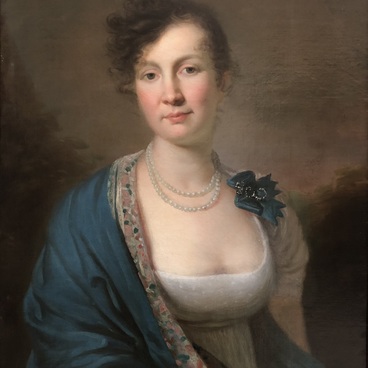Solomon Epstein created Visiting Zaven. Conversations in 1985.
The second title of the work is ‘Our everyday life’. The master depicted Leningrad artists visiting Zaven Arsha’kuni. The house owner is sitting at the head of the table and his guests talk thoughtfully.
Zaven Arsha’kuni was one of the artists of ‘left’ LOSKH which stands for Leningrad branch of the Union of Artists. The Union continued to gravitate towards socialist realism in the 1970s. But some of its members already held with different views and promoted their individual creative principles. Zaven Arsha’kuni said that he could paint any color with any color.
Solomon Epstein often painted portraits of his contemporaries. Already in his youth he experienced a strong shock from the reproduction of the group portrait of “Syndics” by Rembrandt. Since then, the master came to embrace this genre - he sought to convey the multifaceted relationship between the characters in his works. Epstein’s creations include another group portrait with Zaven Arsha’kuni - the master depicted the artist with his wife and son.
Solomon Epstein’s artistic style has changed over the years. In the 1950s, the artist remained in the mainstream of academism of the early 20th century. At that time, he regularly used a dark background of warm-brown tones.
The master’s palette changed in the 1960s. He began to use light, mostly blue tones. Solomon Epstein traveled a lot along the rivers of the Russian North at that time. On one of such trips he saw Dionysius' frescoes in the St. Therapontus Monastery. He was touched by the joyful and festive works and made two excellent sketches from them. After his travels, the master turned to the light and cold color scheme and a more sweeping manner of painting.
Solomon Epstein’s style had become smooth and pronouncedly musical by the 1980s with his works growing more decorative. Almost all canvases of this period have his favorite checkered pattern. The canvas Visiting Zaven. Conversations belongs to this period. It is a stylized painting created with textured strokes in a decorative manner.
The painting Visiting Zaven. Conversations came to the National Museum of the Republic of Chechnya in 2017 as a donation of Elena and Gennady Timchenko charitable foundation. It gave a total of 144 works of art to the Museum.
The second title of the work is ‘Our everyday life’. The master depicted Leningrad artists visiting Zaven Arsha’kuni. The house owner is sitting at the head of the table and his guests talk thoughtfully.
Zaven Arsha’kuni was one of the artists of ‘left’ LOSKH which stands for Leningrad branch of the Union of Artists. The Union continued to gravitate towards socialist realism in the 1970s. But some of its members already held with different views and promoted their individual creative principles. Zaven Arsha’kuni said that he could paint any color with any color.
Solomon Epstein often painted portraits of his contemporaries. Already in his youth he experienced a strong shock from the reproduction of the group portrait of “Syndics” by Rembrandt. Since then, the master came to embrace this genre - he sought to convey the multifaceted relationship between the characters in his works. Epstein’s creations include another group portrait with Zaven Arsha’kuni - the master depicted the artist with his wife and son.
Solomon Epstein’s artistic style has changed over the years. In the 1950s, the artist remained in the mainstream of academism of the early 20th century. At that time, he regularly used a dark background of warm-brown tones.
The master’s palette changed in the 1960s. He began to use light, mostly blue tones. Solomon Epstein traveled a lot along the rivers of the Russian North at that time. On one of such trips he saw Dionysius' frescoes in the St. Therapontus Monastery. He was touched by the joyful and festive works and made two excellent sketches from them. After his travels, the master turned to the light and cold color scheme and a more sweeping manner of painting.
Solomon Epstein’s style had become smooth and pronouncedly musical by the 1980s with his works growing more decorative. Almost all canvases of this period have his favorite checkered pattern. The canvas Visiting Zaven. Conversations belongs to this period. It is a stylized painting created with textured strokes in a decorative manner.
The painting Visiting Zaven. Conversations came to the National Museum of the Republic of Chechnya in 2017 as a donation of Elena and Gennady Timchenko charitable foundation. It gave a total of 144 works of art to the Museum.

